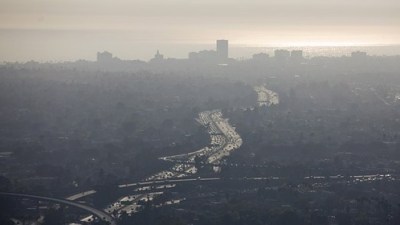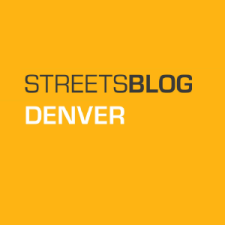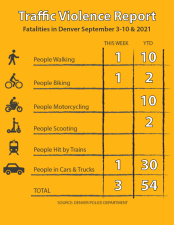Presenting the Denver Streetsies: The Best and Worst of 2017

At the end of every year Streetsblog Denver asks readers to vote on the most memorable events of the past 12 months — both good and bad.
We put seven categories up for a vote over the holidays. Here’s what you told us.
Best Street Transformation: 14th Street

A year made a big difference on 14th Street downtown, where people on bikes now enjoy the protection of concrete curbs and parked cars for most of the mile-long stretch between Market Street and Colfax Avenue.
It’s not perfect — drivers turning right across the lane don’t always yield to cyclists going straight, and gaps in the curbs still enable drivers to park illegally, forcing bicyclists into traffic.
But 14th is the city’s most robust bikeway in terms of physical protection. It’s also an improvement over Denver Public Works’ typical toolkit of flimsy plastic posts, paint, signs, and parked cars (when they happen to be around). The improvements have slimmed down the street, too, which is less of a speedway.
What Denver Should Be Most Embarrassed About: Widening I-70

While other cities are opting out of environmentally destructive, traffic-inducing highway projects — or even tearing them down — Denver officials and the Colorado Department of Transportation stubbornly insist on widening I-70 through north Denver neighborhoods.
If CDOT gets its way, the footprint of an expanded I-70 in Elyria and Swansea will be about three times what it is today.
Transportation experts — and Governor John Hickenlooper — know that widening highways does not fix congestion and actually makes traffic worse by generating more car trips. Hickenlooper, his roads agency, Mayor Michael Hancock, and the City Council that signed a funding agreement with CDOT are all guilty of perpetuating this zombie project that will displace residents and businesses in predominantly low-income minority neighborhoods.
What Denver Should Be Most Proud Of: Voting to Support Walking, Biking, and Transit

Denver voters showed they’re ready for a multi-modal approach to transportation by passing a $431 million bond focused on walking, biking, and transit projects. Among other improvements, the package funds sidewalks, protected bike lanes, and true bus rapid transit on East Colfax Avenue.
Sure, the package isn’t perfect and includes some relics of the cars-first era, like the widening of 56th Avenue. But on balance, the strong vote in favor of a project list that’s weighted heavily toward safer streets and better transit is a welcome sign that the city is ready to leave the days of car-centric planning behind.
Best Deal for Transit Riders: More Modern Fare Options
Voters said RTD’s mobile ticketing app and its reusable “smart card” were hugely important for bus and rail riders in 2017. They were split as to which matters more: Each piece of fare tech garnered 34 percent in this category.
Here’s hoping the transit agency will embrace other steps to improve the rider experience in 2018, like real-time arrival displays and dignified shelters and seating at bus stops.
Worst Deal for Transit Riders: Legislature Robs Millions From RTD
Senate Bill 267 was supposed to boost RTD coffers by allocating some marijuana tax money to Colorado’s largest transit agency. A typo in the bill language slipped passed state lawmakers of both sides of the aisle. Without a fix, the underfunded RTD stands to lose about $6 million annually.
You’d think lawmakers would want to correct the error. Think again.
Governor Hickenlooper convened a special session in October to do just that, but Republican lawmakers threw a tantrum over being called back to the capitol. The GOP ignored calls from transit-dependent people like Joe Lamers, who is blind, and blocked the bill.
Most Absurd Media Take on Urban Streets: Neil Westergaard Stereotypes Bus Riders
Neil Westergaard, the editor-in-chief of the Denver Business Journal, attempted to discredit the Colfax bus rapid transit project with one of his cranky columns abhorring change. This time he relied unapologetically on lazy stereotypes, framing bus riders as “belligerant [sic], dirty, smelly, disruptive and dangerous people.”
Westergaard specializes in writing about Denver’s streets as a cultural battlefield where your mode of travel dictates your tribe, not public resources that should move all people safely and efficiently.
He won’t be around to bully people much longer, though — he’s set to retire early this year.
What Denver Should Be Most Hopeful About: A Frequent Transit Grid

Readers are most excited for changes to transit service in Denver proper that will make traveling by bus faster and easier.
It’s called a frequent transit grid, and if done right, people will be able to get most places in the city with one transfer tops, day or night, without having to look at a schedule.
There’s one big question mark: How will the city pay for these service improvements and the changes to the public right of way they’ll require? The answer should become clearer in the year ahead, and Streetsblog will be following closely.
Happy 2018, Denver.



